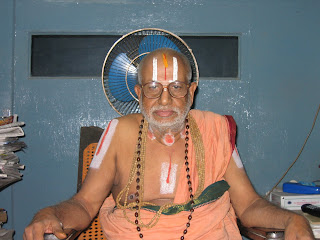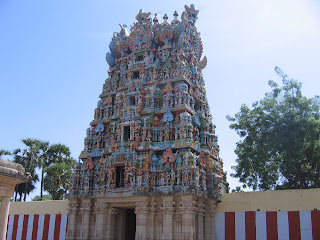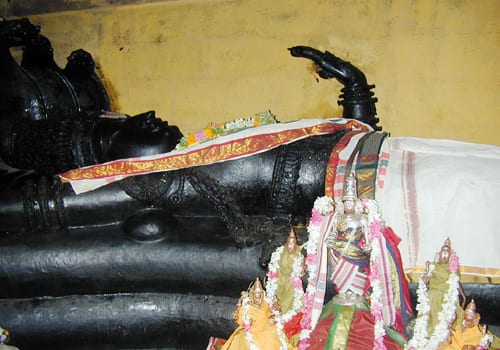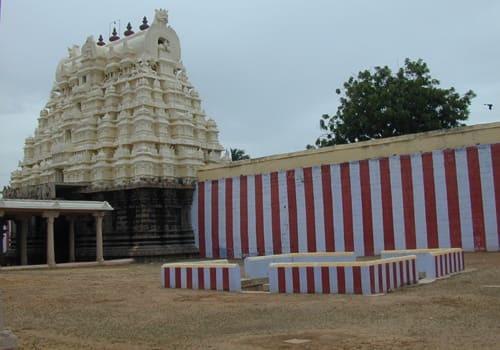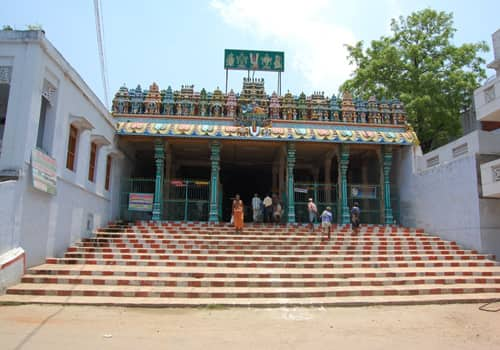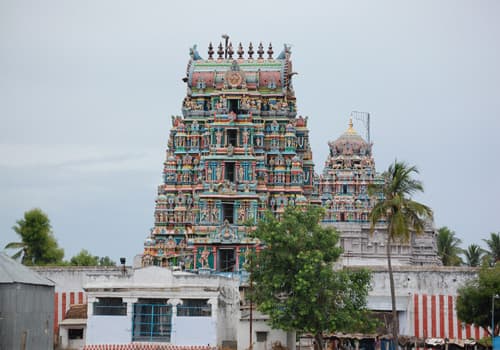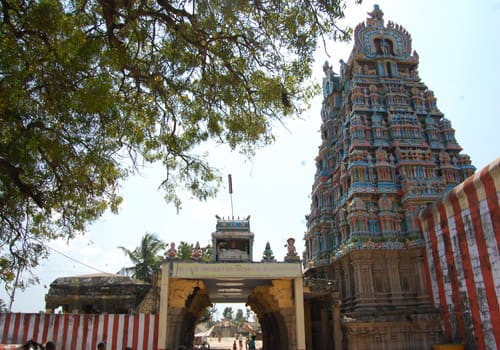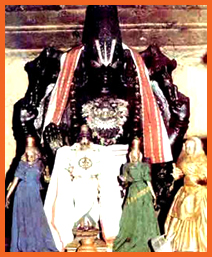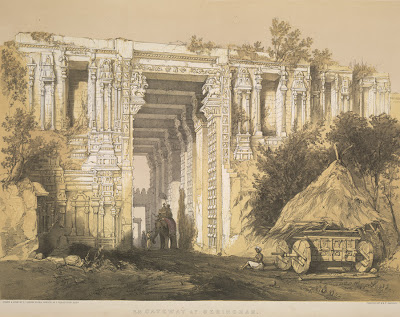P.J.
0
Divya Desam 88-Thiru Vanparisaram - Sri Kuralappa Perumal Temple
Divya Desam 88- Thiru Vanparisaram - Sri Kuralappa Perumal Temple

The TempleThiruppathisaram, also known as Thiruvanparisaram is to the north-east of Nagercoil in Kanyakumari district, around 3.5 km from Nagercoil city centre. The place derives its name from a 5000 year old temple dedicated to Thiruvazhimarban (Lord in whose heart Thiru - Goddess Padmavati abodes) Lord Vishnu. Thiruppathisaram is part of the 108 Divya Desams and Malai Nattu Thiruppatigal. The mother of Nammalvar, a Vaishnavite poet-saint, was born in this village
Legend has it that Lakshmi fearing the fierce form of Narasimha following his slaying Hiranya, meditated upon him; Vishnu upon assuming a Shanta Swaroopam upon Prahladan's request, proceded in search of Lakshmi, who assumed his chest as her permanent abode (Shria Pati Sancharam hence Tirupatisaram). Legend has it that Vibhishana was blessed with a vision of the coronation of Rama, here at Tirupatisaaram (while returning to Lanka).
Udayanangai -and her husband Kaari (both devotees of Vishnu), are believed to have celebrated Vamanajayanti here (on the bright ekadashi in the month of Virgo), and begotten Nammalwar on Vaikasi Vishakam. Legend also has it that the 7 Saptarishis meditated upon Vishnu here and were blessed with his divine vision (as in Tirupuliyur).. It is believed that the waters of the temple tank have miraculous healing properties. Specials:
1. Periya pirattiyar, who is generally found on the right side of the heart of Sriman Narayanan, is found on the left side of this sthala perumal.
2. Banyan tree is found near the Lakshmi Theertham, which is capable of curing diseases and it is also said to be the hamsam of the perumal.
3 This Divyadesam, Thiruvanparisaram has a relation with Tamil Nadu, Kerala and Karnataka. This place is the birth sthalam of Udaya nangai, mother of Nammalwar. This perumal is worshipped and the pooja is done by the Andhanars of Udipi, in Karnataka.
There are several interesting stories relating to this Divya Desam.
1. Lord Vishnu appears as Rama providing darshan to New Lankan King

Vibheeshana, after attending the Ramar Pattabhishekam in Ayodhya, came to Srirangam where he had to let go the idol of Lord Ranganatha on the Cauvery river banks. On his way back to Lanka from Srirangam, with his thoughts centred around Rama, he is said have visited this place and offered his prayers here.
When the Lord appeared before him and asked for a wish, Vibheeshana wanted to see Rama once again. It is believed that Lord Vishnu provided darshan to Vibheeshana as Rama. Hence, one finds Rama, Sita and Lakshmana to the right of the moolavar deity here.
2. Birth place of NammAzhvaar’s mother

Thiruvanparisaram is the birth place of Udaya Nangai. She was married to a man from Kurugur. Being childless, she undertook a 41 day penance here as instructed the Thirukurungudi Lord Nambi. As a result of this penance, NammAzhvaar was born to them. However, immediately after his birth, he sat under the Tamarind tree in (Azhvaar)Tirunagari and remained speechless for several years.
3. Rishis directed to Parisaram
Wanting the darshan of Lord Vishnu, Saptha Rishis undertook penance near Suchindram. They were re-directed to undertake further penance about 10kms North West of Suchindram. It is believed that Lord Vishnu provided darshan to these seven rishis at Thiruvanparisaram.
4. The Name- Thiruvazhmarban
After the killing of Asura Hiranyan, Lord Narasimha was in an angry mood. Lakshmi is said to have undertaken penance here to cool down the Lord. As per the request of Prahalad, Lord came here searching for Lakshmi. Happy to find her Lord again and in a cool form as a Shantha Swaroopi, Lakshmi is said to have requested the Lord to provide her a place in his heart which the Lord readily accepted.
As Lakshmi resides in the chest of the Lord at this temple, he came to be called Thiru Vazh Marban.
Presentation of Ramayana
Acceding to the request of Anjaneya, Sage Agasthya is said to have presented the entire story of Ramayana at this place for the benefit of the devotees. In memory of this event, one sees Anjaneya with folded hands addressing Sage Agasthya, who is in a seated posture opposite him. Also, seen in this sannidhi are Lankan King Vibheeshana and Kulasekara Azhvaar.
NammAzhvaar as a child
NammAzhvaar, who was born after the 41 day penance of his mother at this place, is seen as a small child at this temple, to the left of Thiruvazhmarban. This is a special feature at this Divya Desam.
NammAzhvaar in his single paasuram(3699) says:
Varuvar Selvar VanParisarathu Iruntha En
ThirVazhMarvarku En Thiram Sollaar, Seivathu En
Uru Aar Sakkaram Sangu Sumanthu Ingu Ummodu
Orupaadu Uzhalvaan, Or Adiyaanum Ulan Enrey
Kulasekara Azhvaar’s contribution
Kulasekara Azhvaar is said to have renovated the temple and built walls and provided Vahanam for the Lord for his procession on special festive occasions.
Moolavar:
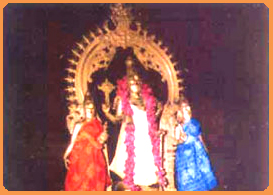
The Moolavar of this sthalam is Thirukkuralappan. He is also named as "Thiruvaazh maarbhan".
Moolavar in Veetrirundha (sitting) thirukkolam facing his thirumugham towards East direction.
Prathyaksham for Vindhai, Kaari, Udaya Nangai and Garudan.
Thayaar
The Thaayar of this sthalam is Kamala valli Naachiyaar.
Mangalasasanam:
Lakshmi Theertham.
Vimanam:
Indira Kalyana Vimaanam.
Festivals: Kerala Tantram is the worship protocol followed here. Five services are offered each day. The annual Bhramotsavam is celebrated in the month of Chittirai. Krishna Jayanthi, Saturdays in the month of Purattasi are considered sacred here. Vaikuntha Ekadasi and Aadi Swathi (associated with Kulasekhara Alwar) are also celebrated here.
Temple time: 4am-1030am and 530pm-730pm
Contact : V. Vasudeva Pothy (no telephone or cell phone!!!!)
How to reach the temple
Local town buses from Nagercoil (Anna) bus stand to Thirupathisaram
OM NAMO NARAYANA
http://www.srivari.com/malayalatirupathigal/thiruuvanparisaram.htm
http://aravamudham.blogspot.in/2012/11/thiruvanparisaram-divya-desam.html
http://www.srivaishnava.in/108-divya-desams/item/88-88thiru-van-parisaram.html
https://en.wikipedia.org/wiki/Thiruppathisaram
https://en.wikipedia.org/wiki/Divya_Desam
Divya Desam 88- Thiru Vanparisaram - Sri Kuralappa Perumal Temple

The TempleThiruppathisaram, also known as Thiruvanparisaram is to the north-east of Nagercoil in Kanyakumari district, around 3.5 km from Nagercoil city centre. The place derives its name from a 5000 year old temple dedicated to Thiruvazhimarban (Lord in whose heart Thiru - Goddess Padmavati abodes) Lord Vishnu. Thiruppathisaram is part of the 108 Divya Desams and Malai Nattu Thiruppatigal. The mother of Nammalvar, a Vaishnavite poet-saint, was born in this village
Legend has it that Lakshmi fearing the fierce form of Narasimha following his slaying Hiranya, meditated upon him; Vishnu upon assuming a Shanta Swaroopam upon Prahladan's request, proceded in search of Lakshmi, who assumed his chest as her permanent abode (Shria Pati Sancharam hence Tirupatisaram). Legend has it that Vibhishana was blessed with a vision of the coronation of Rama, here at Tirupatisaaram (while returning to Lanka).
Udayanangai -and her husband Kaari (both devotees of Vishnu), are believed to have celebrated Vamanajayanti here (on the bright ekadashi in the month of Virgo), and begotten Nammalwar on Vaikasi Vishakam. Legend also has it that the 7 Saptarishis meditated upon Vishnu here and were blessed with his divine vision (as in Tirupuliyur).. It is believed that the waters of the temple tank have miraculous healing properties. Specials:
1. Periya pirattiyar, who is generally found on the right side of the heart of Sriman Narayanan, is found on the left side of this sthala perumal.
2. Banyan tree is found near the Lakshmi Theertham, which is capable of curing diseases and it is also said to be the hamsam of the perumal.
3 This Divyadesam, Thiruvanparisaram has a relation with Tamil Nadu, Kerala and Karnataka. This place is the birth sthalam of Udaya nangai, mother of Nammalwar. This perumal is worshipped and the pooja is done by the Andhanars of Udipi, in Karnataka.
There are several interesting stories relating to this Divya Desam.
1. Lord Vishnu appears as Rama providing darshan to New Lankan King

Vibheeshana, after attending the Ramar Pattabhishekam in Ayodhya, came to Srirangam where he had to let go the idol of Lord Ranganatha on the Cauvery river banks. On his way back to Lanka from Srirangam, with his thoughts centred around Rama, he is said have visited this place and offered his prayers here.
When the Lord appeared before him and asked for a wish, Vibheeshana wanted to see Rama once again. It is believed that Lord Vishnu provided darshan to Vibheeshana as Rama. Hence, one finds Rama, Sita and Lakshmana to the right of the moolavar deity here.
2. Birth place of NammAzhvaar’s mother

Thiruvanparisaram is the birth place of Udaya Nangai. She was married to a man from Kurugur. Being childless, she undertook a 41 day penance here as instructed the Thirukurungudi Lord Nambi. As a result of this penance, NammAzhvaar was born to them. However, immediately after his birth, he sat under the Tamarind tree in (Azhvaar)Tirunagari and remained speechless for several years.
3. Rishis directed to Parisaram
Wanting the darshan of Lord Vishnu, Saptha Rishis undertook penance near Suchindram. They were re-directed to undertake further penance about 10kms North West of Suchindram. It is believed that Lord Vishnu provided darshan to these seven rishis at Thiruvanparisaram.
4. The Name- Thiruvazhmarban
After the killing of Asura Hiranyan, Lord Narasimha was in an angry mood. Lakshmi is said to have undertaken penance here to cool down the Lord. As per the request of Prahalad, Lord came here searching for Lakshmi. Happy to find her Lord again and in a cool form as a Shantha Swaroopi, Lakshmi is said to have requested the Lord to provide her a place in his heart which the Lord readily accepted.
As Lakshmi resides in the chest of the Lord at this temple, he came to be called Thiru Vazh Marban.
Presentation of Ramayana
Acceding to the request of Anjaneya, Sage Agasthya is said to have presented the entire story of Ramayana at this place for the benefit of the devotees. In memory of this event, one sees Anjaneya with folded hands addressing Sage Agasthya, who is in a seated posture opposite him. Also, seen in this sannidhi are Lankan King Vibheeshana and Kulasekara Azhvaar.
NammAzhvaar as a child
NammAzhvaar, who was born after the 41 day penance of his mother at this place, is seen as a small child at this temple, to the left of Thiruvazhmarban. This is a special feature at this Divya Desam.
NammAzhvaar in his single paasuram(3699) says:
Varuvar Selvar VanParisarathu Iruntha En
ThirVazhMarvarku En Thiram Sollaar, Seivathu En
Uru Aar Sakkaram Sangu Sumanthu Ingu Ummodu
Orupaadu Uzhalvaan, Or Adiyaanum Ulan Enrey
Kulasekara Azhvaar’s contribution
Kulasekara Azhvaar is said to have renovated the temple and built walls and provided Vahanam for the Lord for his procession on special festive occasions.
Moolavar:

The Moolavar of this sthalam is Thirukkuralappan. He is also named as "Thiruvaazh maarbhan".
Moolavar in Veetrirundha (sitting) thirukkolam facing his thirumugham towards East direction.
Prathyaksham for Vindhai, Kaari, Udaya Nangai and Garudan.
Thayaar
The Thaayar of this sthalam is Kamala valli Naachiyaar.
Mangalasasanam:
- Nammalwar - 1 Paasuram.
Lakshmi Theertham.
Vimanam:
Indira Kalyana Vimaanam.
Festivals: Kerala Tantram is the worship protocol followed here. Five services are offered each day. The annual Bhramotsavam is celebrated in the month of Chittirai. Krishna Jayanthi, Saturdays in the month of Purattasi are considered sacred here. Vaikuntha Ekadasi and Aadi Swathi (associated with Kulasekhara Alwar) are also celebrated here.
Temple time: 4am-1030am and 530pm-730pm
Contact : V. Vasudeva Pothy (no telephone or cell phone!!!!)
How to reach the temple
Local town buses from Nagercoil (Anna) bus stand to Thirupathisaram
OM NAMO NARAYANA
http://www.srivari.com/malayalatirupathigal/thiruuvanparisaram.htm
http://aravamudham.blogspot.in/2012/11/thiruvanparisaram-divya-desam.html
http://www.srivaishnava.in/108-divya-desams/item/88-88thiru-van-parisaram.html
https://en.wikipedia.org/wiki/Thiruppathisaram
https://en.wikipedia.org/wiki/Divya_Desam






